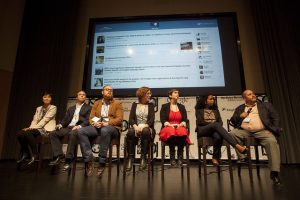9 Newspapers and Digital News

“In the very first month of Indian Opinion, I realized that the sole aim of journalism should be service. The newspaper press is a great power, but just as an unchained torrent of water submerges whole countrysides and devastates crops, even so an uncontrolled pen serves but to destroy. If the control is from without, it proves more poisonous than want of control. It can be profitable only when exercised from within. If this line of reasoning is correct, how many of the journals in the world would stand the test? But who would stop those that are useless? And who should be the judge? The useful and the useless must, like good and evil generally, go on together, and man must make his choice.” — Mahatma Gandhi from his book The Story of My Experiments with Truth, 1982
Threats to Ethical Journalism are Threats to Democracy
Since the website Newspaper Death Watch was founded in early 2007, at least 15 metropolitan daily newspapers have kicked the ink bucket. The “death watch” site focuses on metropolitan daily newspapers — those that cover large cities or a few geographically connected smaller cities. Since small-town newspapers come and go more often and typically do not set the news agenda for hundreds of thousands of people, they are not tracked by the site. Nevertheless, any time a newspaper stops publishing it removes a vital community resource.
When people lament the decline of newspapers, it is not only the ink on paper they worry about. The loss of news-gathering staff and editors hurts democracy because our political system is built on the assumption that citizens need information to make informed decisions, to vote and to communicate with elected officials. In the United States, the professional news media are under attack by politicians, particularly those on the extreme right. As the song goes, “You don’t know what you’ve got ’til it’s gone.” Mistrust of the free press leads to the destruction of free speech and the erosion of personal liberty.

In the book The Elements of Journalism, Bill Kovach and Tom Rosenstiel write of the clampdown on the media in Soviet-influenced Poland in 1981. The Polish government declared martial law and stopped the free broadcast of news, replacing it with state-controlled media. When the state media shows came on, people protested by walking their dogs to city parks and discussing current events. They also used video cameras to create their own documentaries. They used journalism made by regular people, known as citizen journalism, to express their desire for freedom and to stay informed. Kovach and Rosenstiel argue that the Polish people used journalism to support democratic liberty.
It should not have to come to this in America. Free speech and the norms of professional journalists are worthy of popular protection. We live in a digital media environment awash with information. Only a portion of the messages on social media come from professional news organizations that work to reinforce their stories with balanced fact-seeking and fact-checking. Preserving carefully reported, factual news is in the interest of the republic. The slow journalism movement seeks to protect accuracy and care in journalism. Consider learning more about this form of news: It is both a professional movement within the mass communication field and a social movement.
News Norms
As was briefly mentioned in Chapter 1, news norms are the standards that guide professional journalists. The term “norm” refers to a behavior that rational people agree is (or should be) considered normal in society. Journalists are open about their information sources. When they do not disclose the name of a source, they explain as much about the person as they can and they explain why they are not able to say more. Journalists have two major truth strategies that they employ: objectivity and transparency. The objectivity norm refers to efforts to keep individual biases out of the published news and to consider the information presented by sources with an open mind during the information gathering process. No one is completely objective, and no news outlet is, either. Note the difference, however, between opinion content and news content coming from news organizations.
Newspapers will often publish opinions, and this is within the norms of journalism so long as it is labeled as such and it presents a fact-based opinion. Differentiating between opinion content and news content can be difficult for audience members. It is the responsibility of news organizations to explain what they are doing. This is the transparency news norm put into action. Demonstrating transparency in information gathering and publishing requires showing audiences how the news is made. In some cases, it even means inviting audience members to join in the process of reporting professional news stories. Transparency goes beyond presenting two or more extreme points of view on a news topic and calling it fair. Instead, journalists explain the epistemology of news, or how they know what they know. The evolution of news norms is in part a response to the challenges audience members face in trying to figure out whom to trust.
Evolving Ethics
Another norm in newspapers and digital journalism that is rapidly changing is the absolute separation of news and advertising. It used to be called the separation of “church and state” in news: Keeping advertising influence apart from news judgment was as essential to the practice as was the actual separation of church and state in American governance. To retain an objective point of view when covering a community, journalists often tried to ignore news organization revenues and their sources. Now, as news organizations become smaller, journalists often have to be aware of advertisers’ identities and their interests in particular audiences. Journalists have to care about the business.

It goes against codes of ethics to publish news information in direct support of an advertiser, but journalists are increasingly paying attention to what stories and topics are popular. Reactions to this development vary widely. To some, this is the death of ethics in the industry. To others, the idea that advertising and journalism were ever completely separate is a joke. Advertisers, at least in local news environments, are community businesses. They are stakeholders just as other readers are. They should be included as sources of information and opinion. At issue is how much power local businesses should wield, when they should be able to wield it, and whether anyone is harmed when they do. The calculus should perhaps be different for national news organizations who are swayed by huge multinational firms when journalists pay too much attention to the wishes of advertisers.
The concern under this new ethical line of thinking for local journalism is that now advertisers will hold even more sway than they did in the past because revenues are down and news organizations are looking somewhat desperately to sustain the work. Journalists have to work to build audiences without falling into sensationalism and without allowing advertiser influence on news content. It is a daily battle, but it will likely be essential for news organizations moving forward. Appealing to audiences, however, does not mean choosing partisan favorites and feeding audiences what they want. This is a recipe for allowing bad faith into professional news content.
Cable News, Bias and Polarization
The rise of partisan cable news channels has helped to create echo chambers where news consumers can find and then primarily rely on information that confirms their biases. Social media algorithms also feed echo chambers by showing us more content from people we already agree with. These algorithms tend to serve us content resembling what we have already enjoyed in the past, thereby creating a filter bubble. All in all, this makes it a challenge for us to consider other points of view. Combined, echo chambers and filter bubbles in a partisan information environment can create separate realities depending on the politics of groups being served.
The hyper-partisan, divided media landscape creates a problem for news organizations striving to be objective. No matter how they report the news, the facts they present may seem to run contrary to the misinformation or highly-opinionated information people are used to seeing on their social media feeds. This is not to equate misinformation with opinion content. The two are not equivalent. Deeply-held opinions can still be based on facts. Misinformation is dangerous because it is presented in bad faith. That is, the people presenting the information know it is not true and present it regardless. This is several steps beyond having an opinion. This is lying. It happens in echo chambers and sometimes bleeds into otherwise objective news outlets disguised as an equal side of a partisan argument.

What is lost when news consumers fail to think critically about the news and opinion information presented to them is not only the prestige of the newspaper and digital news industry but also the shared narrative. People used to disagree with different opinions being presented in the news, but they generally agreed that what they saw on the news was actually happening. Audiences could disagree on prioritization of information and they could take issue with the frames applied to the news without questioning whether anything and everything was “fake.” Now there is a tendency to trust what is emotionally appealing rather than what is rationally argued or factually accurate. The problem with this should immediately be obvious to anyone following 21st-century American news and politics. People are swayed by passion and opinion, and it is incredibly easy to feel informed by consuming massive amounts of information from social media streams even if those streams are filtered to appeal to our emotions.
People are often overwhelmed when trying to rationally comprehend constant flows of emotional information. The challenge for news consumers is to build and select the best filters. We must take an active role in filtering our own information rather than allowing social media and search engine algorithms to reassure us constantly. It has always been a citizen’s responsibility to be informed. It has never been easier to find information. It has also never been more difficult to navigate information flows, to borrow a concept from noted sociologist Manuel Castells. The idea that we live in an environment of information flows is meant to differentiate our information environment from previous ones where the spread of information was not both instantaneous and massive. Before the global spread of the publicly available high-speed internet access and near constant access to mobile data we had to seek out information. Now, it envelops us. Instead of pulling information into our lives like water onto dry land, we are up to our necks in information and few of us are strong swimmers.
The Importance of Journalism
The good news is that teaching people to be media literate can do something to mitigate this situation. This may be an essential role of journalists in the future. The challenge for contributing to an informed society is no longer to bring people new information but rather to help people to navigate information flows. If the task previously was to source and carry potable water for people, the job of journalists in the future may be to help people navigate oceans of saltwater themselves until we can find fresh water together.
Newspapers and their digital counterparts do not seem poised to do this work alone. The loss of jobs in the past 20 years has been devastating. Local television news outlets are often trusted more than national news outlets. If nothing else, audiences can see that the people delivering our news live in the same community, root for the same sports teams and are subject to the same weather and traffic. Generally speaking, though, local television stations do not employ nearly the number of reporters that newspapers did when they were strong.

The bread and butter for local television news is breaking news and events coverage. Reporting consistently on in-depth issues takes resources and will require a shift in focus for most local television news outfits. Investigative journalism in television newsrooms is on the rise, but having an I-team is not the same as having a half dozen reporters covering City Hall, the statehouse, the local education scene and the business community. Local general assignment television reporters often get their news from newspapers. Television reporters then look to update a story beyond what was published in the newspaper. The term for this is intermedia agenda setting, and it has been seen at the national level as well as the local level. For television stations to capitalize on the trust audiences have and help them navigate the information environment, the industry will have to evolve quickly.
Digital news organizations will also try to pick up the slack. In the 21st century, we have seen the rise of news organizations originating on the Web or as mobile apps. The challenge for BuzzFeed, Vox and other online news operations is to be taken seriously and to maintain strong enough revenues to stay afloat. The digital media environment is notorious for being good for Google and Facebook and bad for everyone else. We continue to examine alternate revenue sources besides advertising. Students interested in being well informed are encouraged to subscribe to the digital versions of their local trusted news outlets.
The Future of Digital News
The future of newspapers and digital news organizations, including the future of broadcast news (as it will be the next to be affected by digital convergence), may be to have news outlets splitting themselves into two-headed monsters. They must keep up with breaking news and be where audiences are in the network society to serve as guides in the sea of information, and they must also be socially responsible community members serving as a check on power by doing original in-depth reporting.
Tools such as Google Analytics, Chartbeat, Adobe Analytics, and others help newsrooms track how they are reaching audiences. The threat is that these tools will direct newsrooms rather than the news information itself being each organization’s compass. As a vast industry, journalism can serve with a renewed sense of purpose if it orients itself to guide rather than lecture media consumers. People eventually learn when they have been lied to, and we have the ability to create a record of who told the truth and who did not. In order to hold people’s attention, we need to perform the services they need most.

